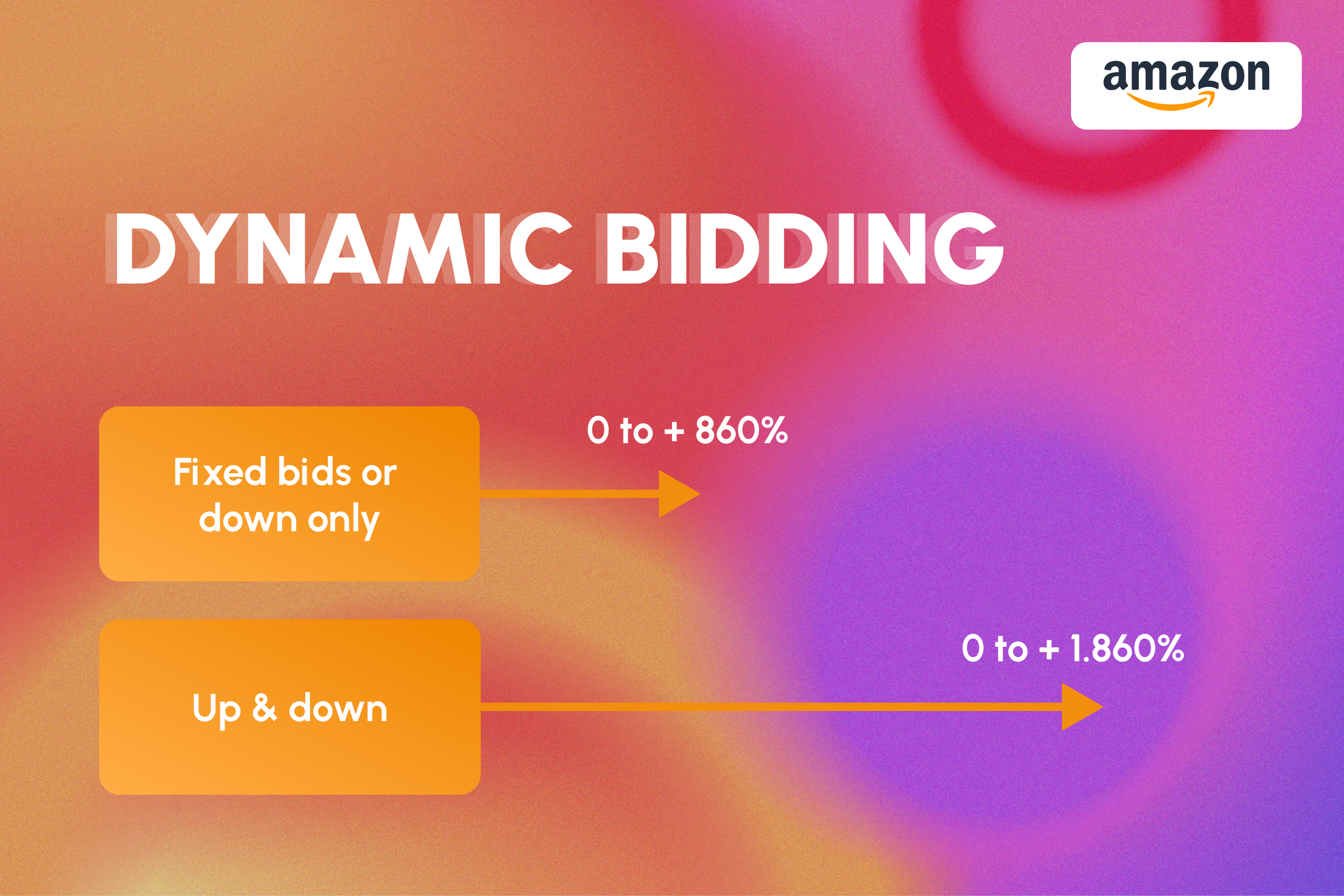Would you like to improve your Amazon sales results whilst decreasing your advertising costs? Well, you’re in the right place because today, I’m going to cover Amazon advertising growth. Firstly we’ll look at some must-know Amazon advertising strategies that will help you increase your sales. These are strategies that you can implement on a weekly and monthly basis to improve your Amazon advertising performance. Then we’ll also look at some suggestions to help you scale your business with Amazon advertising.

Optimise Amazon’s Suggested Bids Weekly
Tip number one is optimising Amazon’s suggested bids every week. So if you’re using Amazon’s suggested bids, they actually update pretty often. Instead of optimising them every day, it’s easier to optimise the bids every seven days, and it’s super simple.
Suppose you’re looking at your Amazon account right now, and you see a campaign that you have Amazon’s suggested bid on; just go ahead and, every seven days, look through those keywords. Then, all you have to do is click ‘apply’, and it’ll automatically update the bids to Amazon’s new suggestions.
Seller Central > Advertising > Campaign Manager > Select a campaign > Click on an ad group > Targeting.

In some instances, the bid will actually increase, so your bid might be much lower than Amazon’s new suggested bid; in that scenario, you would simply click ‘apply’. That
way, you can continually stay within Amazon’s recommended bid range, and many sellers don’t necessarily know this when they’re first creating their campaigns.
When sellers are just starting out, they might see fantastic results at the beginning. However, they may start to see a decline in performance after a while, even though they did use Amazon’s suggested bid. When this happens, the odds are usually that the seller just hasn’t updated their Amazon suggested recommendations regularly enough to improve their advertising performance results.
Negative Keywords optimization
The second Amazon advertising recommendation to improve the performance of your campaigns is to add negative keywords. One of the fastest ways to collect negative keyword data is to simply let an auto campaign run for 30 to 60 days. After that time frame, you’ll be able to download your Amazon advertising reports. You’ll then be able to see placements that have a high ACoS (Advertising Cost of Sale) and those keywords.
Next, you’ll need to add those to your auto and manual campaigns. So to do that, let’s say you’ve already collected data for the last 60 days, and you’re looking at an auto and manual campaign. Simply go to the negative targeting section, and this is where you’ll be able to add your negative keywords.
Seller Central > Advertising > Campaign Manager > Select a campaign > Click on an ad group > Negative targeting.

So Amazon gives you two options when adding negative keywords: ‘phrase’ and ‘exact’. It’s usually recommended that you add both, and again, adding negative keywords simply allows you to refine the search results that Amazon is optimising for your product.
It’s important to note that you don’t want to be on every single product straight away, especially if you’re a beginner selling on Amazon. It’s definitely better to refine where your product is showing up. The best way to do that is to add negative keywords to your campaigns to improve your Amazon advertising performance.

Set Maximum Keyword Spend
This next tip is really useful; you simply look at your product sales price and calculate 40%-50% of that. So, for example, if your product sales price is £10, 40%-50% of that would be £4-£5. If you see any keywords that surpass £4-£5 in ad spend, go ahead and pause them.
Now what this little strategy is doing is that it’s basically saving you a tremendous amount of time and money because for the conversions you do get that are already past that 40%-50% ad spend, you already know that the ACoS for those particular keywords is going to be approaching one hundred percent.
Therefore when you’re looking at your keywords, let’s say your product sales price is £9.99, 40%-50% of that would be £4-£5, so £5 would be your max bid threshold that you’re willing to spend before turning off a keyword. It’s super easy to think about in this regard because if you’re already at 40%-50% of your product sales price in ad spend and still don’t have any conversions on those keywords, you know that the ACoS will be extremely high. So for that reason, to save yourself a significant proportion of resources, you’re going to just pause those keywords ahead of time.
It’s straightforward to do that audit when you’re looking at your keywords, so go through all of the keywords in all of your campaigns and use that max bid threshold. Then, go ahead and start pausing any keywords even if they don’t have any conversions; you know they’re already at that max bid threshold ceiling that you’ve set up, so you can go ahead and begin pausing those.
Seller Central > Advertising > Campaign Manager > Select a campaign > Click on an ad group > Targeting.

What this Amazon advertising strategy does is that it maximises the efficiency of your campaigns. So that way, every marketing pound you have goes to your top-performing keywords to maximise your sales.
Optimising Bid Placements
So the next Amazon advertising suggestion is to optimise your bid placements. It really is effortless to do this particular strategy. All you have to do is go inside of your campaign, click on ‘placements’, and you’ll see that Amazon offers three different types of placements: ‘Top of search’, ‘Product pages’ and ‘Rest of search’.
Seller Central > Advertising > Campaign Manager > Select a campaign > Placements.

Now you can’t actually optimise ‘Rest of search’, but you can optimise the first two, and when you’re looking at these placements, you’ll be able to easily see which one is doing better than another. The best way to optimise this is just to increase the percentage where you’re doing really well.
So all you’re doing is telling Amazon to go ahead and increase your bid. For example, if your bid is one pound by default, Amazon will be able to raise your bid automatically for you to £1.50 to improve your impressions for that particular placement. When looking at it that way, you’ll see that you’re feeding more fuel in advertising spend to your top-performing placements. You’re letting the other one still collect impressions but just not as many impressions as your top-performing placement.
You can go ahead and go through all of your different campaigns and look at the placements that are doing the best. Maybe in some instances, product pages are doing better for your
campaigns, so in that case, you could adjust it 50% that way. So look through all of your campaigns and simply change the percentage. That way, you’ll be able to give more resources to your top Amazon advertising placements and improve your overall campaign performance.

Optimise Your Bid Strategy
The following Amazon advertising tip is another easy one. All you’re going to do is optimise your bid strategy. So, by default, when you’re creating any campaign, Amazon will use the ‘Dynamic bids – down only’ bid strategy, and that essentially means that they’ll lower your bid when the ad is less likely to convert to a sale.
Now they do offer two other bid strategies, which are ‘Dynamic bids – up and down’ and ‘Fixed bids’. For ‘Dynamic bids – up and down’, they’ll not only lower your bid when the ad is less likely to convert to a sale, but when Amazon see opportunities to increase your bid to capture a sale, they’ll go ahead and increase the bids for your campaigns to maximise your sales.
The third bid strategy is ‘Fixed bids’, and with this one, they actually won’t touch the bids at all, so it’ll just stay at whatever bid you’ve set it at. Now between those three bid strategies, the default is the ‘Dynamic bids – down only’ option, and though it might sound like an optimal place to start, it’s also Amazon’s default bid strategy. So you’re going to want to experiment with all three different techniques in order to find which one works best for your account.
You’re probably thinking, “If the default bid strategy is ‘down only’, why would I ever change it? I would much rather spend less money to make a sale and have Amazon optimise that”. Whilst that may be true, remember that it is the same default strategy that every Amazon seller will also be using, so it might not serve you the best in the long run if that’s the one that you stick with.
Next, it’s time to test them. So the first seven days that you have a campaign running go ahead and use Amazon’s default bid strategy; the second week, you can change it to the ‘up and down’ technique and the third week, you can try the ‘fixed bids’ method.
Now on the fourth week, it’s time to analyse the data. Be sure you’re keeping track of each week’s results, and as you’re keeping track of each week’s results, you’ll be able to see a winner between the three different bid strategies.
So go with whatever bid strategy the data proves to work best for your account. A good place to start when it comes to percentages is 50% for both top of search and product pages, that way, you’re giving Amazon some wiggle room to optimise both for lower bids and higher bids.
How To Scale Using Amazon Advertising
ACoS (Advertising Cost of Sale) Scraping
I think most sellers are probably already aware of this strategy; it’s called ACoS scraping. Essentially, this is going into your search term reports regularly, being consistent with this and finding the search terms and the ASINs that have converted and moving them into other ads.
Next, you take those search terms and ASINs and use them across all your different advert types. So that’s your automated campaigns, manual campaigns, and inside your sponsored product ads because this will then start to feed all of your other campaigns.
This way, you’re starting to learn about what’s converting, and you’re taking that information, and you’re using it to scale up your business.
Running Single Keyword Campaigns
Now, this suggestion is a bit of a controversial one. Of course, not everyone does these types of campaigns, but there are specific benefits to running single keyword campaigns.
Let’s start from the beginning. Let’s say you go into the search report, and you see that there’s a search term that is performing phenomenally well inside your campaign as a phrase match. Now, you can take that search term, isolate it, and create a unique single keyword campaign using that keyword as the only keyword inside the campaign.
What does that do? It gives you a lot more flexibility for the performance of that keyword. So you can actually tweak the performance just for that keyword which you can’t do if there are multiple keywords inside a campaign. You can also do things like placement modifiers and dynamic bidding specifically to that keyword.
Therefore if you have a perfect keyword that’s performing, break it out, separate it and experiment with it. This gives you the ultimate amount of control for that keyword, yes, it’s a little more work when it comes to optimising, but it gives you a lot more ownership over the performance of that keyword.
Adjust Your Amazon Bidding Strategy
The next option is to adjust your bidding strategy. As covered earlier, most sellers start off with ‘Dynamic bids – down only’, and that’s a great way to start, and you’ll see that this is the default setting on campaigns.
Before 2019 ‘Dynamic bids – down only’ was what all sellers were using. Now there are also these options: ‘Dynamic bids – up and down’ and ‘Fixed bids’. So you have the choice to use ‘Fixed bids’ for launching a campaign and then also use ‘Dynamic bids – down only’ as sort of a safe approach because Amazon can lower your bid if they don’t believe it will convert, but they won’t raise it.
With ‘Dynamic bids – up and down’, Amazon will raise your bid up to a hundred percent higher if there’s a likely chance of a conversion. This approach is really only in your interests if you have an excellent listing, a good ASIN, and a well-seasoned campaign.
So a strategy to use to scale is to change your bidding strategy from ‘Dynamic bids – down only’ to ‘Dynamic bids – up and down’. Please note that this is only meant for campaigns that have been around for a while and are performing well.
It is recommended to test this out thoroughly because obviously, it’s not always going to work out in your favour. However, this is an opportunity to scale because essentially, Amazon now has the data from that campaign; they have the conversion data. So using that data, they can then use their system to potentially raise your bid when there is a good chance that you’ll get the sale.

Uncap Your Budgets (Where Applicable)
The next suggestion is to uncap your budgets where applicable. This is important because if you have a low budget on a campaign, specifically one that’s doing well, you’re, in essence, putting constraints on that campaign. You want to tell Amazon, “Hey, if this campaign is doing well, I want to be seen and have visibility at all times”. So you don’t want to hinder a campaign unnecessarily.
So this strategy is called ‘Uncapping’. Primarily you want to put your campaign budget much higher than the daily ad spend for this particular campaign because you want to uncap the budget and give Amazon more freedom to show your ads whenever they can.

Be Creative
Creativity is undoubtedly coming into the mix now more than ever with Amazon advertising. Back in the day, it was straightforward to set up campaigns; however, now you have to be innovative, and taking the time to come up with new creative ideas gives you a unique advantage over your competition.
Those who schedule a time to allow themselves to be creative will usually pull ahead of their competition, but what do I mean by being ‘creative’? Well, it essentially means thinking laterally. You could spend the time doing any number of valuable things. For example, you could go on Amazon, and you could look at your competitor’s ads, their videos, their lifestyle photos, and start to think about where you could make some tweaks and improvements to your adverts to make them even better.
You can even go off of Amazon and head over to Instagram to look at the hashtag of your main keywords. Then, start to see what the followers of that hashtag are doing, what they like, and what they do not like. That’s just the tip of the iceberg of how you can set up that creative advantage and do the market research necessary to compete.
Ask yourself how you can portray your brand so that it’s a higher value than your competition? Also, go into your listing, look at reviews, check out what people say about your brand and your products. Then, use that custom creative headline to get ahead and to resonate with your shoppers. All of these things will make a massive difference if you spend the time to do them; plus, they’ll ultimately help you scale your business.
There you have it, must-know amazon advertising tips to improve your sales performance. Be sure to bookmark this article so that you can use it as a reference on your Amazon advertising journey. If you’re questioning whether to start selling on Amazon or need support with your business and are looking to grow your sales further or maybe even get set up, contact us today. One of our team will reach out to set up a call and discuss the support that you need.








